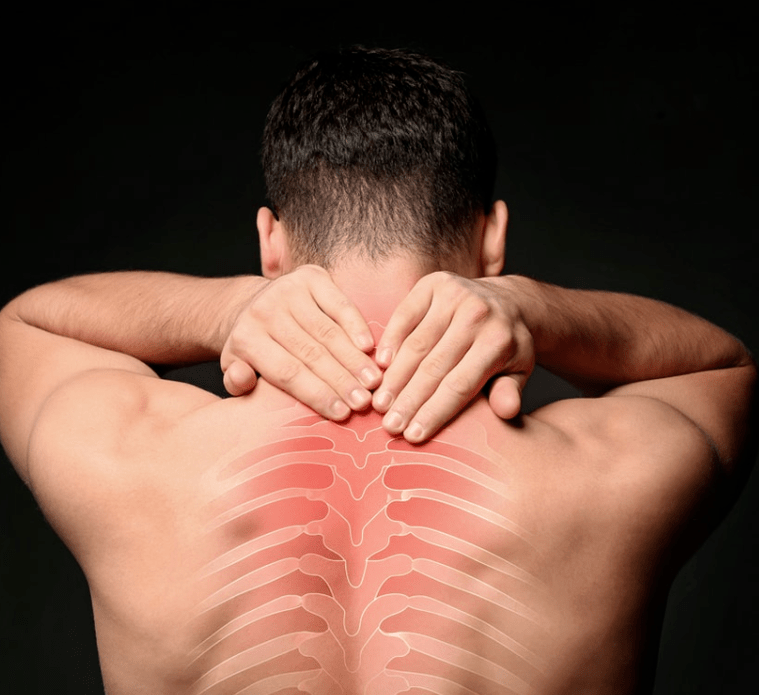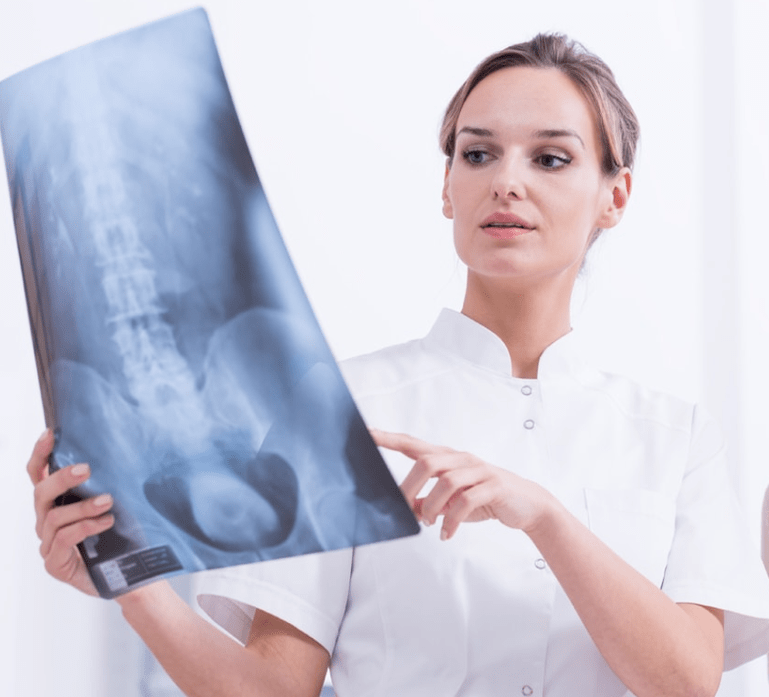
Osteochondrosis is the most common of all diseases of the spine. Since osteochondrosis is a direct dystrophic-degenerative lesion of the discs located between the vertebrae, then, as a consequence, this leads to an irreversible change in their structure, as well as in the shape of the discs themselves, which constitute the thoracic spine E
As a person gets older, these changes in their spine develop more and more, and at the age of about 40-45, almost everyone suffers from osteochondrosis of the spine. By itself, osteochondrosis of the thoracic spine develops much less frequently than, for example, in the lumbar or cervical spine, as the vertebrae in it are much less mobile than in other vertebrae. In addition, the back area in the chest area has a more developed muscle corset, which supports the spine in the chest area much better than in others.
What is this osteochondrosis of the chest?
Chest osteochondrosisdirectly represents a stratification of the discs between the vertebrae while reducing their thickness and, consequently, the consequent pinching of the nerve endings located in the intercostal zone of the human thorax.
However, we note once again that due to the fact that the normal attachment from the sides in humans is rather rigid, the spine in the chest area is less susceptible to osteochondrosis. It is thoracic osteochondrosis which is a rare phenomenon, for example, osteochondrosis of the cervix or lumbar spine.
Usually, with osteochondrosis of the thoracic spine, the pathological process involves the discs between the vertebrae of the thoracic spine, which includes twelve thoracic vertebrae. But more often with osteochondrosis of the thoracic region, pathological changes occur with the upper thoracic vertebrae. There are different degrees of damage with thoracic osteochondrosis and we will look at them in more detail later.
Predisposing factors for the development of thoracic osteochondrosis
The exact causes of osteochondrosis of the thoracic region have not yet been fully documented by modern science. At present, it is common to distinguish in medicine the following predisposing factors or so-called risk factors, due to which osteochondrosis of the thoracic region occurs in the spine:
- hereditary predisposition
- excessive physical activity in this part of the spine.
- spinal cord injury, such as falls or bruises on the chest.
- age-related changes in the intervertebral discs that lead to a reduction in hydration of the disc tissues.
- violations of the blood supply to the chest area.
Causes that contribute to the disease of osteochondrosis of the chest
Mainly, the development of the disease with osteochondrosis is generally promoted by weakness, ie lack of muscle loads, leading to weakening of the functions of the muscular corset and, as a result, to increased loads on the intervertebral discs and ligaments.
Additional reasons for the development of thoracic osteochondrosis are:
- hypothermia of the body.
- the presence of chronic stressful situations.
- transmitted infections;
- difficult working conditions;
- hormonal disorders occurred in the body.
- violation of the metabolic process in the body.
- the presence of congenital defects of the spine, ie the thoracic region.
During exposure to a combination of these factors, or sometimes even one, dystrophic-degenerative irreversible processes develop in the discs between the vertebrae over time:
- the pulposus nucleus of the intervertebral disc gradually begins to lose fluid, which is secreted by them to provide a lubricating function, which ultimately significantly reduces the damping function of this disc.
- the fibrous ring of the vertebrae themselves, due to the increased load on it, becomes more vulnerable, which in turn leads to its gradual destruction.
Symptoms and signs of thoracic osteochondrosis of the spine
The clinical symptoms of thoracic osteochondrosis depend entirely on the following factors:
- the age of the patient;
- the degree of affection for the disease;
- Stages of osteochondrosis of the thoracic spine: depression or exacerbation.
The main signs of osteochondrosis of the chest are:
- chest pain in the spine, the so-called dorsago.
- painful damage to the nerve endings of the spinal cord - rhizopathy.
- abdominal syndrome;
- heart syndrome or changes in the heart muscle, with characteristic pains that persist even under the influence of trinitroglycerin.
- pulmonary syndrome, in the form of stagnation in the lungs with signs of hypoxia, ie suffocation.
No increase in body temperature is observed in a patient with osteochondrosis of the chest, which is also a direct differential diagnostic sign. The dorsal lesion in the thoracic region as one of the main symptoms of osteochondrosis indicates the appearance of cracks in the fibrous ring and deformation of the nucleus accumbens. On palpation, the pain in this area of the chest only intensifies, the symptoms increase.
In addition, the typical symptoms of thoracic osteochondrosis with compression myelopathy, ie deformity of the nerve endings, are:
- goose bumps - hallucinations.
- Pain along the compressed nerve - are common symptoms.
- reduction in temperature and touch sensitivity.
- Disorders of motor function of the spine are also one of the characteristic symptoms.
Having detected such symptoms, you should see a specialist. The appearance of symptoms in the band and their intensity are particularly dangerous. At the same time, it is inappropriate to treat the symptoms without eliminating the causes and factors of the disease.
Degrees of the disease with thoracic osteochondrosis
Each stage of the disease with osteochondrosis of the chest is characterized by its own pathology, which has only its own clinical signs. Modern medicine distinguishes four degrees of degenerative disease of the thoracic disc (similarly - degenerative disease of the lumbar and cervical) and, consequently, four periods of its development. Let's look at them in more detail.
First degree,for which it is characteristic that cracks appear in the fibrous ring, into which the pulposus nucleus then penetrates. This period of development of the disease with osteochondrosis of the chest is characterized by the following symptoms:
- the appearance of pain in the spine that does not exceed the location of the lesion.
- These pains can be either permanent or expressed by the lumbar spine.
- There may be spasmodic muscle contraction in the chest area, accompanied by pain in the heart area.
Second degreeThe development of osteochondrosis of the thorax is characterized by the pathological appearance of increased intervertebral motility with the following clinical manifestations:
- flare-ups occur in the thoracic spine.
- the pain increases during movement.
- discomfort occurs with prolonged posture.
Third degreecharacterized by rupture of the fibrous ring and exit of the nucleus from its boundaries. During this period of the disease with osteochondrosis of the thoracic spine, intervertebral hernias begin to appear, the clinical signs of which are rather intense. That is-neurovascular, muscle tonic and reflex-dystrophic.
In addition to the above, for the third degree of osteochondrosis of the thoracic region, a change in the following conditions of the spine is typical:
- weak stabilization of the position of the spine.
- restriction of mobility of the spine area, manifested in the form of kyphosis or scoliosis.
Fourth degree- the dystrophic-degenerative process already affects all the structures surrounding the spine. This pathological process involves the yolk sac, intervertebral discs, and other ligaments, and fibrosis occurs in the structures surrounding the spine. In this period of the disease with thoracic osteochondrosis, the so-called remission condition is clinically observed.
Complications
With the further development of the disease with thoracic osteochondrosis, it is possible to develop simultaneous complications:
- inflammation of the nerve endings of the spinal cord.
- occurrence of intervertebral hernias;
- development of vascular dystonia.
- the development of Schmorl hernia.
- arthritis
- Pathological bone development - osteophytes.
- significant reduction of the spinal canal.
It should be noted that the severity of complications arising from thoracic osteochondrosis depends entirely on the rate of progression of the resulting disease process and, of course, on the effectiveness of methods for the treatment of osteochondrosis of the thoracic spine.
Diagnostics and its methods

In practice, several methods are used to diagnose osteochondrosis of the chest. Of these, the most common is the X-ray examination, the results of which are quite informative. The signs of thoracic osteochondrosis found in this study are as follows:
- the contours of the discs between the vertebrae are broken.
- the edges of the single slabs acquired a wavy character.
- the intervertebral discs have changed shape.
- osteophytes appeared - abnormal bone growths in the spine.
- the hook-shaped processes of the vertebrae have increased and intensified.
- the bodies of the thoracic vertebrae have changed their normal shape.
- the height of the discs between the vertebrae has been significantly reduced.
- disc herniation between the vertebrae formed.
In some cases, a method of diagnosing thoracic osteochondrosis of the spine is applied through an X-ray contrast study, which determines the following signs of this disease:
- in the case of advanced pathology, the contrast agent completely fills the disc between the vertebrae.
- with the aid of a contrast agent, the contours of the nucleus accumbens are visible, which are unequal.
- when the intervertebral disc is destroyed, the contrast penetrates to a large extent beyond its limits, until it penetrates the spinal canal.
Only the right diagnosis can determine the right treatment.
Treatment of osteochondrosis
The treatment of thoracic osteochondrosis is possible in one of the following ways, which is used taking into account the results of the diagnosis of thoracic osteochondrosis, and in particular:
- conservative-traditional treatment of the spine.
- treatment of tracheal osteochondrosis with traction.
- surgery.
The treatment of thoracic osteochondrosis, called conservative, is complex for the treatment of any type of osteochondrosis: drugs, physiotherapy, physiotherapy exercises. Non-steroidal anti-inflammatory drugs (NSAIDs) aim to relieve pain in the spine, which is known to cause thoracic osteochondrosis. It should be noted that these drugs very well eliminate inflammatory processes, as well as the resulting swelling, helping to reduce the compression of nerve roots. In more complex cases of osteochondrosis of the breast, the treating physician may prescribe a number of additional medications, for example, some strong analgesics and muscle relaxants that prevent muscle spasms.
When the pain subsides or manages to stop, that is, during the recession, physiotherapy treatment is prescribed, as well as, in addition, exercise therapy and massage. All of these are important components of a comprehensive treatment. One of the main physiotherapy tools for the treatment and prevention of the disease is the pulse magnetic therapy with the use of special medical devices for clinical and home use.
Only magnetic therapy of specific parameters is allowed for use during exacerbations; there are medical devices for the treatment of both acute and chronic pain. This system is also suitable for the treatment of lumbar and cervical spine.
In addition to the above, traction therapy, ie the treatment of osteochondrosis of the chest through special traction, can be used successfully to treat osteochondrosis of the chest. With this method, the paravertebral muscles, tissues and ligaments are stretched, which leads to an increase in the intervertebral distance. Even a millimeter and a half will already be enough to reduce swelling, eliminate compression, and relieve tension in the muscles next to the spine. In any case, the main principle of conservative treatment is its complexity. Treatment should be done for a long time and regularly, this is the only way to hope for results.
But surgery as a type of treatment for osteochondrosis is recommended only when the above methods of treating thoracic osteochondrosis do not give the desired result.





































